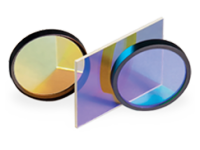Optical Filters for Astronomy Applications - made in USA
We manufacture the highest quality astronomy filters with durable, sputtered hard coatings using single substrates of the best glass, eliminating the need for laminations. All primary filter coatings are applied on the front surface and anti-reflection coatings on the rear surface to prevent ghosting and to maximize transmission.
Highly precise and accurate, the passbands of these filters remain spectrally stable and do not drift in response to extreme temperature fluctuations or changes in humidity. All filters may be used with apertures of f/4 or smaller. We provide custom coating services for more demanding imaging applications requiring larger apertures such as f/3 or f/2. We also can provide larger sizes and unique passbands upon request.
Astrophotography

Filters & Filter Sets
- Durable sputtered coatings
- Thickness: 3.0mm
- Filters designed for use with CCD and for f/4.0 or slower
- Transmitted wavefront better than 0.25 waves/inch
Chroma Filters |
Chroma Technology Corp
The exploration of the universe has made enormous progress in recent decades, with advanced technologies and innovative instruments playing a key role. In this context, the introduction of chroma filters has marked a revolutionary step in astronomical research. These sophisticated filters allow scientists to precisely analyse the light spectrum of celestial bodies, opening up new horizons for discoveries in the cosmos.
Chroma filters: a technological masterpiece:
Chroma filters are specially developed optical filters that are able to isolate certain wavelengths of light. They are used in astronomy to specifically analyse the light emitted by stars, galaxies and other celestial bodies. These filters are able to filter out narrow bandwidths of the electromagnetic spectrum, enabling astronomers to extract specific information about chemical compositions, temperatures and other characteristic features of celestial objects.
Applications in astronomical research:
The application of chroma filters in astronomical research is diverse and has the potential to fundamentally expand our understanding of the universe. One example is the study of exoplanets. Through the targeted use of chroma filters, astronomers can gather information about the atmospheres of exoplanets, which in turn allows conclusions to be drawn about possible living conditions.
Another area of application is the investigation of star-forming regions. Chroma filters allow researchers to analyse the specific emissions of gases and dust in these regions, leading to a deeper understanding of the processes that lead to the formation of stars and planetary systems.
Future prospects:
The integration of chroma filters into astronomical instruments is expected to continue to grow as researchers constantly seek innovative methods to extract precise data from the universe. As this technology continues to evolve, we can prepare for exciting discoveries and new insights that will expand our understanding of cosmic reality.










